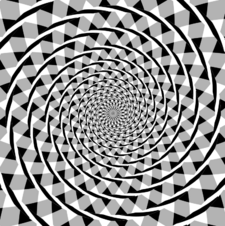Physics:Fraser spiral illusion
The Fraser spiral illusion is an optical illusion that was first described by the British psychologist Sir James Fraser (1863–1936) in 1908.[1]
The illusion is also known as the false spiral, or by its original name, the twisted cord illusion. The overlapping black arc segments appear to form a spiral; however, the arcs are a series of concentric circles.
The visual distortion is produced by combining a regular line pattern (the circles) with misaligned parts (the differently colored strands).[2] Zöllner's illusion and the café wall illusion are based on a similar principle, like many other visual effects, in which a sequence of tilted elements causes the eye to perceive phantom twists and deviations.
The illusion is augmented by the spiral components in the checkered background. It is a unique illusion, where the observer can verify the concentric strands manually.[3] When the strands are highlighted in a different colour, it becomes obvious to the observer that no spiral is present.[4]
See also
- Op-art
- Mathematics and art
References
- ↑ Fraser J (1908) A New Visual Illusion of Direction. British Journal of Psychology 2:307–320
- ↑ Cucker, Felipe (2013). Manifold Mirrors: The Crossing Paths of the Arts and Mathematics. Cambridge University Press. pp. 163–166. ISBN 978-0-521-72876-8.
- ↑ Stern, Tom (October 1, 2013). Philosophy and Theatre: An Introduction. Routledge. p. 57. ISBN 9781134575985. https://books.google.com/books?id=VfwhAQAAQBAJ&pg=PA57.
- ↑ See Bach, Michael. "Fraser Illusion". Visual Phenomena & Optical Illusions. http://www.michaelbach.de/ot/ang_fraser/index.html.
External links
| Wikimedia Commons has media related to Optical illusion. |
- Fraser's Spiral from MathWorld
- Bach, Michael. "Fraser Illusion". Visual Phenomena & Optical Illusions. http://www.michaelbach.de/ot/ang_fraser/index.html. An interactive Fraser Spiral
 |


